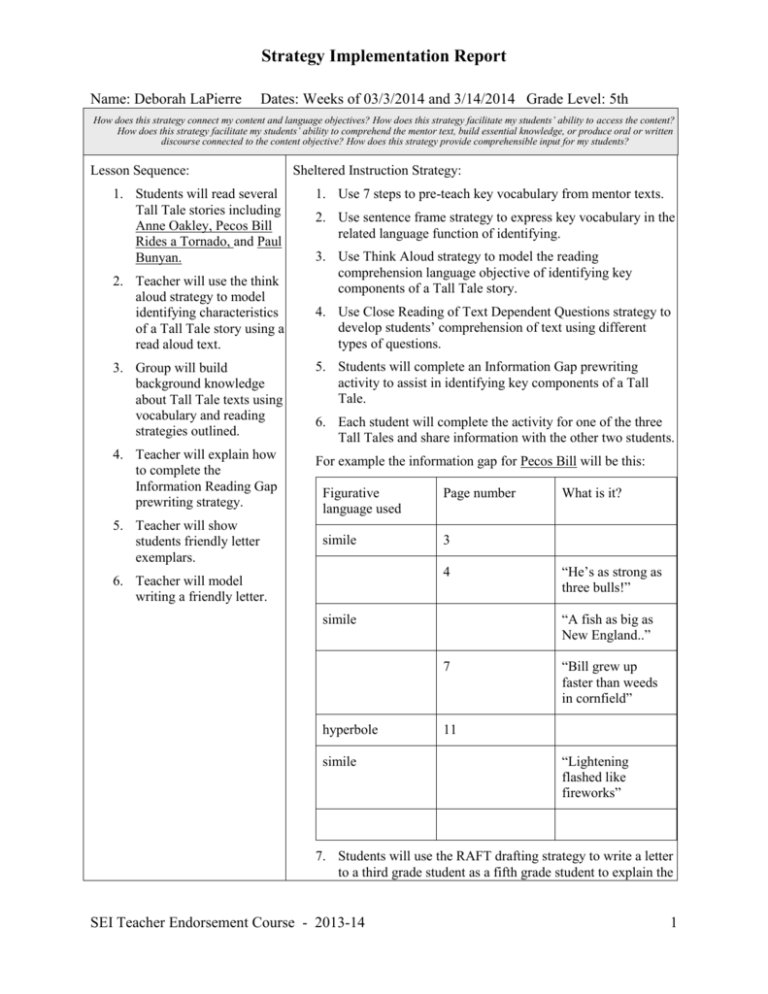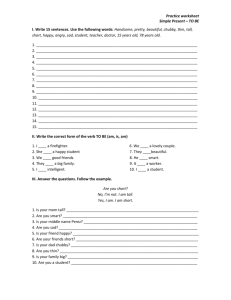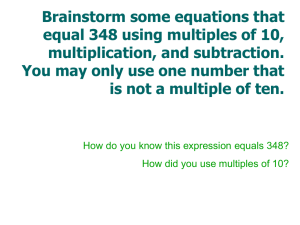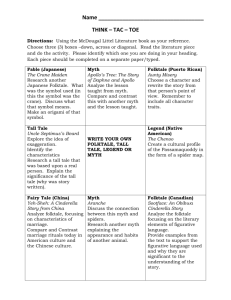Strategy Implementation Report
advertisement

Strategy Implementation Report Name: Deborah LaPierre Dates: Weeks of 03/3/2014 and 3/14/2014 Grade Level: 5th How does this strategy connect my content and language objectives? How does this strategy facilitate my students’ ability to access the content? How does this strategy facilitate my students’ ability to comprehend the mentor text, build essential knowledge, or produce oral or written discourse connected to the content objective? How does this strategy provide comprehensible input for my students? Lesson Sequence: 1. Students will read several Tall Tale stories including Anne Oakley, Pecos Bill Rides a Tornado, and Paul Bunyan. 2. Teacher will use the think aloud strategy to model identifying characteristics of a Tall Tale story using a read aloud text. Sheltered Instruction Strategy: 1. Use 7 steps to pre-teach key vocabulary from mentor texts. 2. Use sentence frame strategy to express key vocabulary in the related language function of identifying. 3. Use Think Aloud strategy to model the reading comprehension language objective of identifying key components of a Tall Tale story. 4. Use Close Reading of Text Dependent Questions strategy to develop students’ comprehension of text using different types of questions. 3. Group will build background knowledge about Tall Tale texts using vocabulary and reading strategies outlined. 5. Students will complete an Information Gap prewriting activity to assist in identifying key components of a Tall Tale. 4. Teacher will explain how to complete the Information Reading Gap prewriting strategy. For example the information gap for Pecos Bill will be this: 5. Teacher will show students friendly letter exemplars. 6. Each student will complete the activity for one of the three Tall Tales and share information with the other two students. Figurative language used Page number simile 3 4 6. Teacher will model writing a friendly letter. 7 simile “He’s as strong as three bulls!” “A fish as big as New England..” simile hyperbole What is it? “Bill grew up faster than weeds in cornfield” 11 “Lightening flashed like fireworks” 7. Students will use the RAFT drafting strategy to write a letter to a third grade student as a fifth grade student to explain the SEI Teacher Endorsement Course - 2013-14 1 Strategy Implementation Report characteristics of a Tall Tale story. Content Objective: Role Audience Format/genre Topic fifth grade student Third grade student Letter/figurative Tall Tales language Language Objective: Language Objectives should be directly linked to the language Students will identify and explain the similar characteristics of Tall Tale stories. skills students will need to be successful in achieving the content objective. Students will explain the importance of figurative language in Tall Tale stories. Language Objective Differentiation for Proficiency Levels: There is one level 4 ELL student in this group. I will give all students a visual poster in the class with the definition of the different types of figurative language and an example of each. I will also give the level 4 student a letter frame template with proper form and spacing for a letter. Content and Concept Language Integration: How have I integrated all possible domains into my teaching and learning strategies and activities? How did this strategy help to make the content comprehensible to ELLs in my classroom? By first using the seven step strategy to pre teach the vocabulary in conjunction with the sentence frame strategy I am setting the students up to better comprehend a Tall Tale text embedded with figurative language. The close reading with text dependent questions gives both me and the students an opportunity to monitor their comprehension skills at increasing levels of complexity. At this point the students have the skills they need in order to begin the writing phase of the unit. By using the Information Gap prewriting strategy the students are able to focus on the key concepts that they will need in order to successfully draft their RAFT. By supporting level 4 ELLs and all students with letter writing models and a letter frame template, prewriting and drafting stages are appropriately SEI Teacher Endorsement Course - 2013-14 2 Strategy Implementation Report scaffolded. By combining instructional strategies designed to support ELLs in content and concept language integration, utilizing all four key domains of language: listening, reading, speaking, and writing my students had the best possible chance for success in meeting the content objective. How did this strategy help the ELLs in my classroom to produce academic language and discourse? All of these strategies helped the ELL students in my group access the content vocabulary, better comprehend the genre of Tall Tales, and demonstrate their understanding of figurative language on their way to successfully meeting the content objective for the unit. As Gee, Halliday, and Schleppegrell remind us, “the amount and quality of this…writing also needs to be matched to the specific context for the students to be able to think and write as scientists, historians, or mathematicians…” In order for ELL students and in fact all students to be able to better understand figurative language it needs to be imbedded in high quality instruction using authentic and linguistically demanding literature. By utilizing the strategies that I have learned to teach vocabulary, reading comprehension, and prewriting strategies in these lessons, my students are developing schema about figurative language and how it impacts writing across genres. To increase my ELLs’ engagement and interaction, the next time I try this strategy, I would … The next time I try this strategy, I would provide my students with sentence starters to complete different points in their letters prior to their drafting instead of after. I believe this would allow us to focus on other areas during the editing phase of the writing process, such as consistency of verb tense and punctuation. Because they are not only ELL students but also special education students they often need the important connecting words and phrases given to them. Many of them have disabilities in communication, language, and writing that compound their difficulties with written language. SEI Teacher Endorsement Course - 2013-14 3







